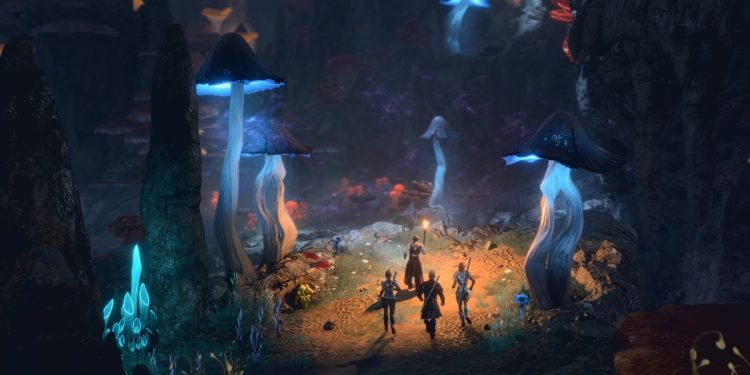To paraphrase Carl Sagan: In order to understand if Baldur’s Gate 3 is a good video game, you must first reckon with the unlikely corporate empire that is Dungeons & Dragons.
On the one hand, evaluating the overwhelming successes of Baldur’s Gate 3 is easy: The game is a masterpiece. The depth of its characters, the complexities of its narrative, the staggering amount of stuff you can do in this game is almost too much to wrap your head around. It is a game so gargantuan, it’s remarkable that so much of it feels so personal, so bespoke. But the longer that I spend with it, the more that I discover friction between the game and me.
It’s hard to lay all my issues directly at Baldur’s Gate 3’s feet, or even at its developer, Larian Studios. It’s Dungeons & Dragons. I’m afraid that the tabletop game, from which Baldur’s Gate 3 draws all of its mechanical systems, is a tedious, unfun system in which to play a video game. I’m not even sure there’s a solution to these mechanical nitpicks, either. Baldur’s Gate 3 is tied to D&D in every possible way, including its lore, and the newfound popularity of the tabletop RPG is part of the reason that Larian’s adaptation has been such a success.
Baldur’s Gate, the place, is a location in the D&D setting the Forgotten Realms, a generic but also dense and weird fantasy setting with elves, dwarves, knights, magic, and what have you. The Forgotten Realms have been adapted into video games a few times: Icewind Dale and Neverwinter Nights also take place here.
This year’s Dungeons & Dragons: Honor Among Thieves movie sets the stage in the same place, and Baldur’s Gate, the location, also gets name-dropped. Baldur’s Gate 3 is now part of a broad corporate empire that spans the entire length of the tabletop gaming space. When the first Baldur’s Gate was released in 1998, there was no such thing as an actual play podcast — there wasn’t such a thing as a podcast at all. Now, a filmed playthrough of Dungeons & Dragons can become so popular it turns into an animated television show, as in the case of the massively popular Critical Role. D&D is the most popular it’s ever been; it’s reached an escape velocity from the niche of nerd culture. All things considered, now feels like an appropriate time to ask: Is this game any good?

Image: Larian Studios
The more I play Baldur’s Gate 3, the more I fear that the answer to that question is no. Despite the many pleasures of Baldur’s Gate 3, which is every inch a D&D role-playing game, every time I play it, I’m reminded of all the limits of its tabletop source material.
Baldur’s Gate 3’s combat encounters are particularly tedious. I have taken to saving right before I enter any combat encounter so that I can start over the second things start to go sour. But no matter how much I prep, how much I plan, or how many times I load my save, something can randomly go wrong. Once, when I was finally making headway into a goblin camp, a goblin sprang up from the bushes and kicked Astarion into a chasm to his death. My jaw dropped open in shock — I had been doing so well! But this game, like D&D, is run on a series of dice. In this case, however, the Dungeon Master — Baldur’s Gate 3 itself — doesn’t fudge any rolls, or take sympathy on a player that was too ambitious. Players must play the rolls they are given, even when it leads to utter disaster. The choice you’re then faced with is whether to roll with the punches or reload from an old save.
The fiddliness of positioning, sightlines, spell slots, and all the other rigmarole that you have to pay attention to in combat lies in stark contrast to the ease and delightfulness of the narrative gameplay. Especially when you’re just chitchatting with the other characters in your party — here, the game is not just fun, but a joyful expression of creativity. It’s here that Baldur’s Gate 3 really embraces what makes D&D so compelling: playing pretend. The characters often comment on the events of the plot, and also ask you, the player, what you think about things. As you react to the world, it fills in around you in your imagination, bolstered by the excellent character writing and voice acting from your companions. Astarion in particular is a delight, a vampire’s spawn that has embraced his newfound freedom so hard that he’s become Hedonism Bot from Futurama.

Image: Larian Studios
But the way this game uses the systems of D&D to fill out the rest of its world shows you its limits, or at least the limits of using it as the basis of your video game. What makes D&D fun, at least in my experience, has very little to do with the campaign, or following all the rules correctly, or the lore of the Forgotten Realms. What makes it fun to gather around a table and tell a story with other people is using your imagination — sometimes to the point of frustrating your Dungeon Master.
My partner tells a great story where he, as the Dungeon Master, planned out a huge combat encounter with a cyber dragon, but because he described the cyber dragon as crying out in pain from his cybernetic implants, the party wanted to help the dragon rather than fight him. But the Dungeon Master that exists within Baldur’s Gate 3 isn’t your friend, or a guy you met at the game store, or a nerd at a convention. It’s a computer program, and one that isn’t necessarily designed to give allowances for the kinds of flights of fancy that can make a game truly memorable. What my partner did, and what led to a memorable play session, is adjust the game to meet the story the players wanted to tell. But Baldur’s Gate 3 can’t do that. It’s not a person with imagination or empathy; it’s a very specifically designed program meant to deliver a narrative experience that can only be stretched so far. It’s an expansive, detailed experience, but there is only one ultimate narrative that Larian has built for you. The Dungeon Master that lives in this game can’t bend to meet you in the middle.
It also is a video game, and a kind of game where showing off the complexity of the combat system is the point. The issue here is that while the combat system is complex, it’s also unforgiving. If you’re not always using every single spell, item, and bonus action you have to defeat the enemy characters, you’re probably going to lose. The high stakes of combat can sometimes make it incredibly thrilling — luring enemies onto your grease puddle and then hitting them with a fire arrow, exploding everyone, will never not be satisfying. But too often you end up quick-saving and reloading because your well-made plans are thwarted by bad dice rolls.

Image: Larian Studios
This is one of the reasons I’ve made a habit of playing characters with high charisma when I play tabletop games. Creating a character that can talk themselves out of any jam is rewarding in a couple of different ways. It gets me out of combat encounters, which are by far my least favorite thing to do in the game. It also makes me feel like a full collaborator in the story the DM is telling; using my enormous brain and appealing to the DM’s agency, we can change the fabric of the tale itself.
It is true that Baldur’s Gate 3 is so packed full of stuff that the game can occasionally feel alive with possibility. The scope of its vision reminds me of Crusader Kings 3 or Dwarf Fortress, games whose creators not only attempt to create entire living worlds, but also make worlds that have an ever-flowing river of history, impacted by the player’s choices. Whenever you make a dialogue choice or interact with a character or even just walk past something in Baldur’s Gate 3, you often hear the distant sound cue of dice rolling — a signal to the player that the game is making a calculation based on something you may or may not be aware of. There’s always the feeling that the world of Baldur’s Gate 3 exists beyond and without you, especially when the game takes you by surprise. But where games like Dwarf Fortress or Crusader Kings 3 feel flexible, Baldur’s Gate 3 can sometimes feel rigid.

Image: Larian Studios
To put it bluntly, while the game allows me to do an incredible range of things as a player, including interrogating any dead body I find or talking up a storm with every rat in a dungeon, there’s absolutely no way it could account for everything a player wants to do. There are combat encounters I can’t cheese my way through in Baldur’s Gate 3, and ones that I can’t talk my way out of. There are plans I can’t put into action because I can’t wear the computer program down with my insistence that I should be able to do something. Sometimes, when you pull off a chain reaction of elemental damage or fuck with enemy NPCs by surrounding them with barrels until their pathing breaks, the game feels like a creative collaboration between storytellers, like a good tabletop game session does. But then, sometimes, I’ll have finally gotten through a combat encounter that I’d spent hours working on, trying every single tool in my arsenal, saving and reloading dozens of times, only to discover that I can’t revive a teammate I desperately need because they’re stuck on a rock.
I look forward to playing, and replaying and replaying, Baldur’s Gate 3 for possibly years to come. It’s clearly a role-playing game classic and has already been an overwhelming success for Larian Studios. It’s just unfortunate that I end up comparing the relatively limited power of a video game to the power of my own imagination — and it also feels like a problem the game can’t solve. Baldur’s Gate 3 is a masterpiece of a D&D game in every sense of the word, for good and, sometimes, for ill.
Baldur’s Gate 3 was released on Aug. 3 on Windows PC. It will be released on PlayStation 5 on Sept. 6. The game was reviewed on PC using a pre-release download code provided by Larian Studios. Vox Media has affiliate partnerships. These do not influence editorial content, though Vox Media may earn commissions for products purchased via affiliate links. You can find additional information about Polygon’s ethics policy here.
























































